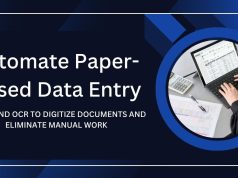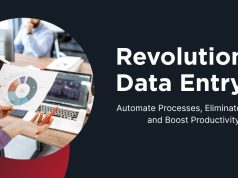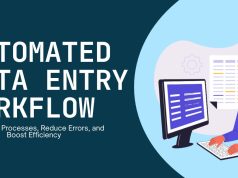Data entry gobbles up man-hours, sours upon man-hours for organizations in every country, and yet many are still utilizing manual methods which bleed time and cause unnecessary mistakes. It can be found in auto-populate data entry forms — smart forms that can revolutionize how your business does data entry and processing.
In this detailed guide, you will learn about the limitations of manual data entry, the value of transitioning to an automated process, and the how-to to get your first automated data entry form off the ground within your organization. You will learn how to select, implement, and avoid common pitfalls and put your company on the path to successful growth through effective data management.
Manual Data Entry – The Costs on the Down-Low
Problems Caused by Inaccuracy Accumulate Over Time
It is inherent that in repetitive processes, humans make errors. Research has provided evidence that the error rate associated with manual data entry is not insubstantial, ranging from around 1-5% which might sound like it isn’t a lot, but it starts to add up ton processing a couple of thousand records. These errors create cascading effects:
-
Inaccurate customer details result in returned deliveries and pissed off customers.
-
Poor financial calculations lead to disputes in charging and lower revenue.
-
Errors in inventory result in stockouts or overstocking.
-
Compliance violations trigger regulatory penalties.

Productivity Drain on Valuable Resources
Manually entering data is one of the time wasters that utilizes an employee’s time, which is better spent on strategic work. Administrative staff waste hours on data entry that could be captured as a digital record from the start, and skilled workers drown in the swamp of data tasks instead of doing what they do best: analyze and decide.
It has a negative effect on morale as well. Manual data entry is generally uninspiring work, and discouragement can drive up employee turnover and recruitment costs.
Scalability Limitations
Manual operations become less and less efficient as companies scale. Solution: onboarding more data entry personnel. This solution seems like the path of least resistance, however, it brings its challenges:
-
There are training costs for every new employee.
-
Quality control is more difficult with many team members.
-
When data entry staff (on- and off-site) are not in constant contact with disease management departments or clinical teams, communication breakdowns arise.
-
The expenses are compounded by the office space and equipment cost.
The Impact of Automated Data Entry Forms on How You Do Business
An automatic data entry form to enter required data in digital format with no human intervention. These systems leverage different technologies—from OCR to AI—to automatically extract, validate, and structure data.
Core Components of Automated Systems
A general form for automated modern data entry may have several basic parts:
-
Data extraction tools capable of extracting data from various sources such as scanned records, PDF files, emails, or forms online. Such systems also read text, numbers, check boxes, and, in some cases, handwriting.
-
Real-time field validation rules to validate data. It does not have to validate email addresses and phone numbers, etc, but it can.
-
Interoperability services linking to other software systems. This secures that recorded data harmonizes smoothly with CRM applications, accounting apps, and other business systems.
-
Workflow automation that dispatches processed data to relevant departments or activates certain processes according to predetermined instructions.
Why Automate Your Data Entry Forms? Key Benefits
Enhanced Accuracy and Data Quality
All those human errors procedure information entry tasks are being done by automated systems. While no system is immune to errors, the error rate drops to under 0.1% once you have correct automation in place.
-
Data accuracy is enhanced throughout every system as the automated processes abide by the same rules on each occasion.
-
Validation in real time: Catch errors before they hit your system.
Significant Speed Improvements
Forms with data entry and data processing are at the speed of light compared to manual data entry forms. This speed edge adds up over time.
-
Batch processing also offers automation capabilities that can handle large amounts of data at one time.
Substantial Cost Savings
-
Lower staff requirements enable companies to redeploy human resources.
-
Better accuracy will lead to lower costs for error correction.
-
Increased productivity reduces costs related to transporting paper, managing documents manually, and using manual filing systems.
Enhanced Compliance and Security
-
Digital systems allowed for monitoring of who accessed information, when changes were made and what approvals were needed.
-
Only with the automation of forms can privacy settings be enforced, data retention policies applied, access restricted, etc.
Picking the Best Automated Data Entry Form Solution
Evaluate Your Existing Volume and Complexity of Data
Begin with an examination of your current data entry needs. Document the kind of forms you deal with, amount of data, and how complex are your data validation requirements.
Evaluate Integration Requirements
Catalog the software you currently have, and look at which of the applications will get and/or send data.
User Experience and Training Requirements to Be Taken Into Account
Seek for the products which provide both user-friendly configuration interfaces, good documentation, and an active support service.
Review Security and Compliance Features
Make sure your desired solution is law-abiding, regardless of GDPR, HIPAA or other regulations or industry standards.
Implementation Best Practices for Success
Start with a Pilot Program
Start small with a pilot program addressing only one form or department.
Invest in Change Management
Create a robust change management plan that includes how to manage employee resistance, training, and celebrating quick wins.
Monitor and Optimize Continuously
Create ongoing monitoring procedures to monitor accuracy levels, cycle times, and user satisfaction.
Real-World Success Stories
Healthcare Administration Transformation
By utilizing an auto-fill form solution, the network decreased its average per-patient registration time from 15 to 3 minutes. Error rates decreased by 85%.
Financial Services Streamlining
The company was able to operate claims 60 per cent faster and with higher rates of accuracy using automated data entry forms.
Manufacturing Supply Chain Optimization
The company decreased invoice processing time by 70% and the cost on late payment penalties to the organization is €61,000.
Data Entry Automation Future You Might Also Like:
Artificial Intelligence Integration
Systems will harness natural language processing to interpret context and intention.
Mobile-First Design
Next-generation solutions will be fully functional on smart phones and tablets.
Enhanced Security Features
Solutions in future will have strong encryption, biometric-based authentication methods to zero-trust security models.
Conclusion
Fillable data entry forms are not just a technology upgrade – they are a strategic investment in the efficiency and competitiveness of your organization. Those who see the most from these solutions do not deploy it like a point product, they operate it strategically, invest in apt knowledge, and continue to re-evaluate for continuous improvement.
Automated data entry forms can and do succeed, but they require management buy-in, user buy-in, and attention to performance metrics. The upfront investment of time and resources gives a return on investment (ROI) through increased accuracy, lowered cost, and greater scalability.
Once your company grows and its needs change, data entry automation forms will change with you, though the savings in time and resources cannot be refuted. The trick, as always, is to begin with a clear sense of your needs, to pick the right solution and to execute it just so.
Establishing trust with potential customers starts long before the first conversation— this article on how blogging builds credibility explains how consistent content creates authority.










